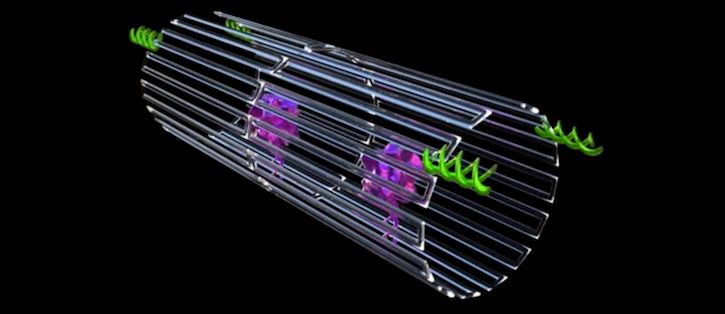The Nanorobots That Could Choke Out a Tumor
"I think we are much closer to real, practical medical applications of the technology."

At Arizona State University (ASU), years of research have poured into the study of nanorobots as cancer-fighting tools. Now, some scientists there think they may be closing in on medical applications for the technology.
"We have developed the first fully autonomous, DNA robotic system for a very precise drug design and targeted cancer therapy," Hao Yan, director of the ASU Biodesign Institute's Center for Molecular Design and Biomimetics, declared in a statement. When people think of nanorobots, they might think of tiny arachnids that fix blood vessels or deliver a drug payload. But some of the smartest, and most promising, building blocks for them might actually be DNA.
Yan and his colleagues have been working on using DNA origami—structures molded or folded from sheets of DNA—for some time now. Most recently, his team employed the technique to build nanorobots that may be able to choke out tumors by cutting off their blood supply.
The structures are comprised of rolled-up DNA sheets packed with molecules of thrombin, a blood-clotting enzyme. They were affixed with a DNA aptamer made to specifically target nucleolin, a protein only found in high concentrations on the surface of tumor endothelial cells.
Delivered by IV into mice with models of breast, lung, melanoma, and ovarian cancers, the nanorobots worked quickly, many locating and congregating around the tumor within 2 hours of injection. After binding to the blood vessel surface, they would release the thrombin into the tumor.
The thrombin would slowly cut off the blood flow to the tumors. Within 3 days, the team observed advanced thrombosis in all the examples, even though the nanobots themselves were typically cleared from the bloodstream within 24 hours. Once coagulation occurs and blood flow has been cut off to the tumor, it shrinks. In the melanoma mouse model, 3 in 8 mice had complete tumor regression.
Survival gains were also substantial in the mice tested with the nanorobot intervention. Median survival time more than doubled in the melanoma model, from a median of 20.5 days up to 45. In a primary mouse lung cancer model, tumor shrinkage was observed after 2 weeks.
An important aspect of such technology is assuring that the thrombin only targets the tumors and doesn’t end up in the brain, where it could cause strokes. The researchers did not find any instances of that occurring in their experiments.
"The nanorobot proved to be safe and immunologically inert for use in normal mice and, also in Bama miniature pigs, showing no detectable changes in normal blood coagulation or cell morphology," said Yuliang Zhao, a professor at the National Center for Nanoscience and Technology (NCNST) of the Chinese Academy of Sciences, which collaborated with ASU researchers on the study.
"I think we are much closer to real, practical medical applications of the technology," Hao Yan said. “Furthermore, the current strategy may be developed as a drug delivery platform for the treatment of other diseases by modification of the geometry of the nanostructures, the targeting groups and the loaded cargoes."
The new report, “A DNA nanorobot functions as a cancer therapeutic in response to a molecular trigger in vivo,” was published online this week in Nature Biotechnology.
Related Coverage:
NIH Hopes to Accelerate Gene Editing Tech With New Funding